WR 124 is a Wolf-Rayet star located approximately 21,000 light-years away in the constellation Sagitta. With an apparent magnitude of 11.50, the star is invisible to the unaided eye. It is one of the fastest-known runaway stars in the Milky Way. It moves with a radial velocity of about 200 km/s.
WR 124 is surrounded by a ring nebula, M1-67, composed of material expelled from the star. The star and the nebula were among the first targets of NASA and ESA’s James Webb Space Telescope (JWST) in June 2022. Webb’s detailed observations showed the clumpy structure of the gas around the hot central star and provided enough detailed information to help astronomers study the essential roles stars like WR 124 play in creating complex molecules, the building blocks of life, and new stars and planets.
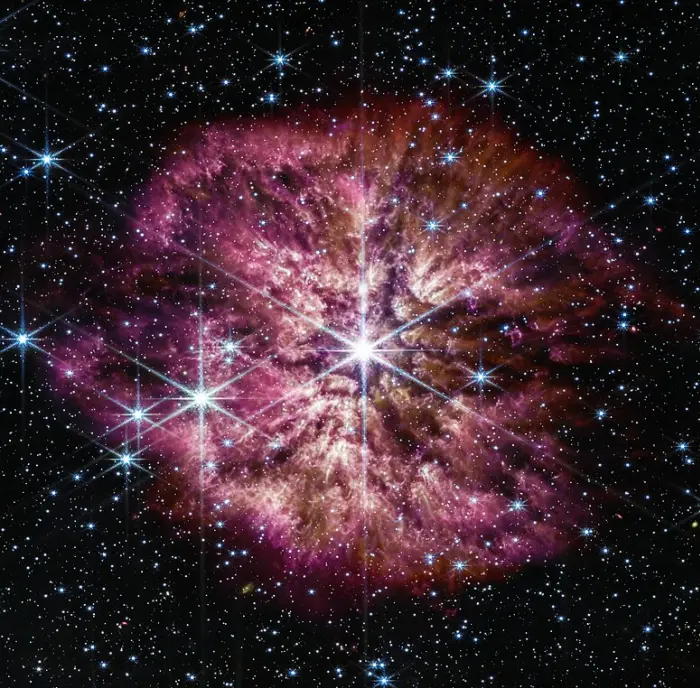
The luminous, hot star Wolf-Rayet 124 (WR 124) is prominent at the centre of the NASA/ESA/CSA James Webb Space Telescope’s composite image combining near-infrared and mid-infrared wavelengths of light. The star displays the characteristic diffraction spikes of Webb’s Near-infrared Camera (NIRCam), caused by the physical structure of the telescope itself. NIRCam effectively balances the brightness of the star with the fainter gas and dust surrounding it, while Webb’s Mid-Infrared Instrument (MIRI) reveals the nebula’s structure. Background stars and galaxies populate the field of view and peek through the nebula of gas and dust that has been ejected from the ageing massive star to span 10 light-years across space. A history of the star’s past episodes of mass loss can be read in the nebula’s structure. Rather than smooth shells, the nebula is formed from random, asymmetric ejections. Bright clumps of gas and dust appear like tadpoles swimming toward the star, their tails streaming out behind them, blown back by the stellar wind. This image combines various filters from both Webb imaging instruments, with the colour red assigned to wavelengths of 4.44, 4.7, 12.8, and 18 microns (F444W, F470N, F1280W, F1800W), green to 2.1, 3.35, and 11.3 microns (F210M, F335M, F1130W), and blue to 0.9, 1.5, and 7.7 microns (F090W, F150W, F770W). Image: credit: NASA, ESA, CSA, STScI, Webb ERO Production Team (CC BY 4.0)
Star type
WR 124 is a Wolf-Rayet star, a hot, massive, evolved star with prominent broad emission lines of ionized helium and carbon or nitrogen. The star has 20 times the mass of the Sun and a radius 11.93 times solar. With an effective temperature of 44,700 K, it is 562,000 times more luminous than the Sun. Most of its energy output is in the ultraviolet band. These parameters are based on the data obtained with the Gaia space observatory (Gaia Data Release 2).
WR 124 was previously believed to have a mass of 33 solar masses and a bolometric luminosity 1,000,000 times that of the Sun based on evolutionary modelling. The models placed the star at a greater distance, about 8.5 kpc (27,700 ly) away.
WR 124 has the stellar classification WN8h, which indicates that it has hydrogen lines in its spectrum. The star is measured to still be 15% hydrogen and is believed to still be burning hydrogen in its core. The remaining mass is mostly helium.
The star has an estimated age of only 8.6 million years. Even though it is still very young, WR 124 is a highly evolved star. It has evolved quickly due to its high mass and is currently going through the brief Wolf-Rayet phase.
WR 124 has only a few hundred thousand years before nuclear fusion in its core stops and it collapses in on itself, producing a brilliant type Ib or Ic supernova. The star is losing mass through a powerful stellar wind at an exorbitant rate, between 10-4 and 10-5 solar masses per year. The history of the star’s mass loss episodes is evident in the structure of the surrounding nebula.
The life cycles of Wolf-Rayet stars are quite short compared to other stars. These stars form from the most massive main sequence stars that lose half or more of their initial mass by the time they evolve into WR stars. For example, Regor (Gamma2 Velorum) in the constellation Vela – the nearest and brightest WR star in the sky – started its life with a mass of at least 40 solar masses and now has a mass about 9 times that of the Sun.
Only some massive stars go through a short Wolf-Rayet phase in the final stages of their lives. Most WR stars are believed to be massive stars that have consumed the hydrogen in their cores and evolved away from the main sequence. They ejected most of their atmospheres, leaving behind a stellar core of helium and the products of the fusion of heavy elements. The expelled material forms turbulent nebulas around the stars. These stars are challenging to study because they are rare, they lie at great distances, and their visible light is blocked by clouds of dust. A subset of WR stars still show hydrogen lines in their spectra and, like WR 124, are classified as WNh stars.
Such high-mass stars are incredibly rare, both because they have short lives and because they do not form as often as lower-mass stars. All these briefly detectable stars are at a crucial period in their life cycles, separated by only hundreds of thousands of years or less from their ultimate fate. They are in the process of expelling their outer layers, which form characteristic halos of gas and dust. WR 124 has already shed about 10 solar masses of material.
WR 124 was once believed to be considerably closer to us. The present distance value of 21,000 light-years is based on the parallax obtained in Gaia Early Data Release 3. The data in the Gaia star catalogues is based on the results obtained by the European Space Agency’s (ESA) Gaia space observatory.
M1-67
WR 124 is surrounded by the nebula M1-67 (Sh 2-80). The hot nebula is composed of dust and material ejected from the star over thousands of years. It is almost 6 light-years across, indicating a dynamical age of about 20,000 years.
The nebula’s structure provides insights into the star’s past episodes of mass ejection. The nebula is not composed of smooth shells, but rather from random, asymmetric ejections.
M1-67 is formed by the dust and gas that are caught up in the star’s powerful stellar wind. The released gas moves at a rate of up to 100,000 mph and carries large glowing blobs away from the nebula. The farther the gas gets, the more it cools, and cosmic dust forms that can be captured in infrared light. Once the star has gone supernova, the dust will be used to shelter forming stars and help form planets.
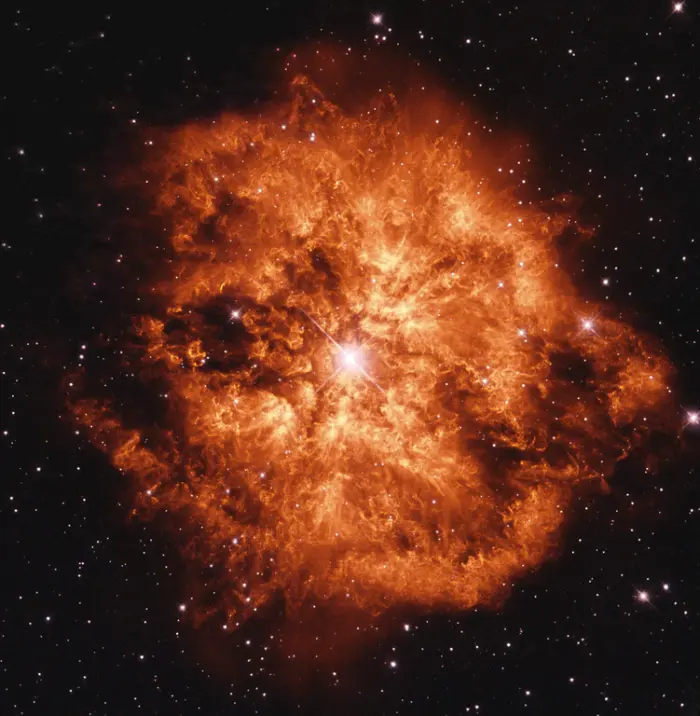
The Wolf-Rayet star WR 124 and the nebula M1-67, image credit: Judy Schmidt (CC0 1.0)
The dust obscures the brightness of WR 124, making the luminous star appear dimmer in visual wavelengths than it would without several magnitudes of extinction.
Like all Wolf-Rayet nebulae, M1-67 has a complex, knotted structure. As the gas and dust nebula interacts with the interstellar medium, it causes a bow shock that moves at a velocity of about 180 km/s. The bow shock is about 1.3 parsecs from the central star.
The nebula is expanding at a rate of more than 150,000 km/h. It contains enormous clumps of material, some of which stretch out to 150 billion kilometres and have a mass 30 times that of Earth. If one of these clumps replaced the Sun at the centre of the solar system, it would extend all the way to Saturn.
Facts
The Wolf-Rayet star WR 124 was discovered by American astronomer Paul W. Merrill in 1938. Merrill, who was the first astronomer to define S-type stars in 1922, specialized in spectroscopy, which he used to study unusual stars. Merrill reported his discovery in The Astronomical Society of the Pacific, describing WR 124 as a “Wolf-Rayet star with high velocity.”
The runaway status of WR 124 was confirmed by observations with the Wide Field and Planetary Camera 2 (WFPC2) on board of the Hubble Space Telescope in 1997 and 2008. The two sets of narrow-band Hα images confirmed that WR 124 was one of the fastest moving stars in the Milky Way. Like many other WN8 stars, it is not associated with a star cluster or a binary system. It may have been ejected from the core of a young cluster via slingshot-type dynamical interaction or it may have been part of a binary system in which the companion went supernova.
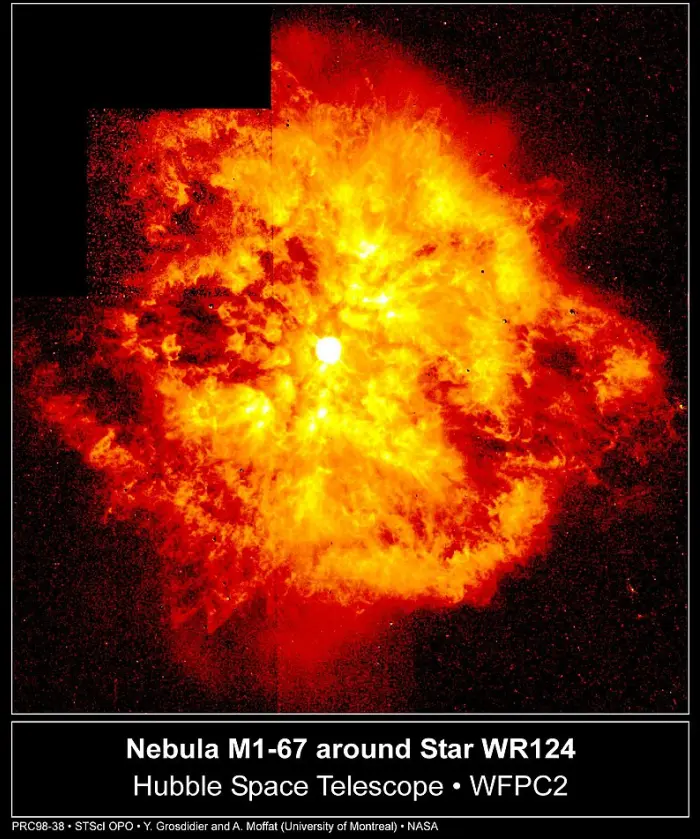
This NASA Hubble Space Telescope picture of the energetic star WR124 reveals it is surrounded by hot clumps of gas being ejected into space at speeds of over 100,000 miles per hour. Also remarkable are vast arcs of glowing gas around the star, which are resolved into filamentary, chaotic substructures, yet with no overall global shell structure. Though the existence of clumps in the winds of hot stars has been deduced through spectroscopic observations of their inner winds, Hubble resolves them directly in the nebula M1-67 around WR124 as 100 billion-mile wide glowing gas blobs. Each blob is about 30 times the mass of the Earth.
The massive, hot central star is known as a Wolf-Rayet star. This extremely rare and short-lived class of super-hot star (in this case 50,000 degrees Kelvin) is going through a transitional phase characterized by the fierce ejection of mass. The blobs may result from the furious stellar wind that does not flow smoothly into space but has instabilities which make it clumpy. Image credit: NASA/Yves Grosdidier (University of Montreal and Observatoire de Strasbourg), Anthony Moffat (Universitie de Montreal), Gilles Joncas (Universite Laval), Agnes Acker (Observatoire de Strasbourg)
The Hubble Space Telescope (HST) carried out the first observations of WR 124 in March 1997. The image taken with the WFPC2 revealed the extended arcs of glowing hot clumps of gas around the star. Hubble directly resolved these clumps for the first time. The optical Hubble image released in 2015 offered a more detailed view of the star and the surrounding nebula.
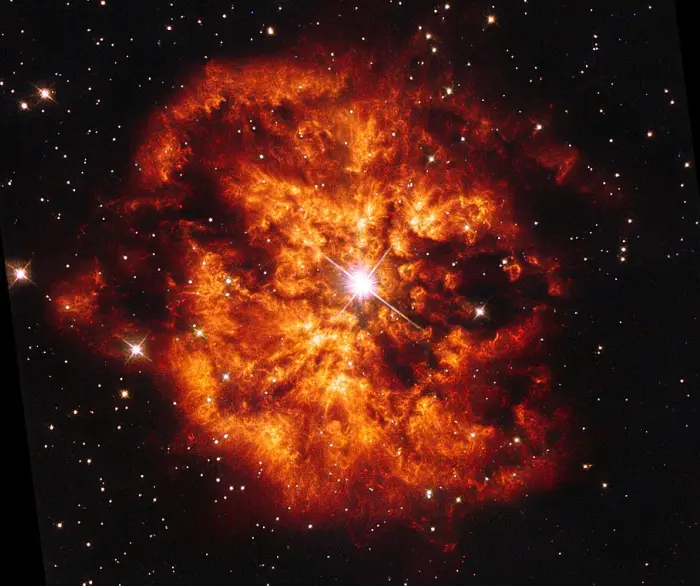
This is an optical image from the NASA/ESA Hubble Space Telescope of the luminous, hot star Wolf-Rayet 124 (WR 124). The image was taken by Hubble’s Wide Field Planetary Camera 2 and was released by ESA/Hubble in 2015. The star shines brightly at the very centre of this image and around the hot clumps of gas are ejected into space at over 150 000 kilometres per hour. Image credit: ESA/Hubble and NASA (CC BY 4.0)
James Webb Space Telescope image
WR 124 was imaged by the James Webb Space Telescope in June 2022. The images taken by Webb’s powerful infrared instruments revealed the nebula around the star in unprecedented detail.
Webb’s detailed image provided a rare sight of a Wolf-Rayet star in the brief period before it goes out as a supernova. The telescope’s Mid-Infrared Instrument (MIRI) captured the cosmic dust surrounding the star, which glows at the longer mid-infrared wavelengths. The images revealed the nebula’s clumpy structure and will help astronomers investigate the origin of cosmic dust and how much dust stars like WR 124 can produce before going out as supernovae.
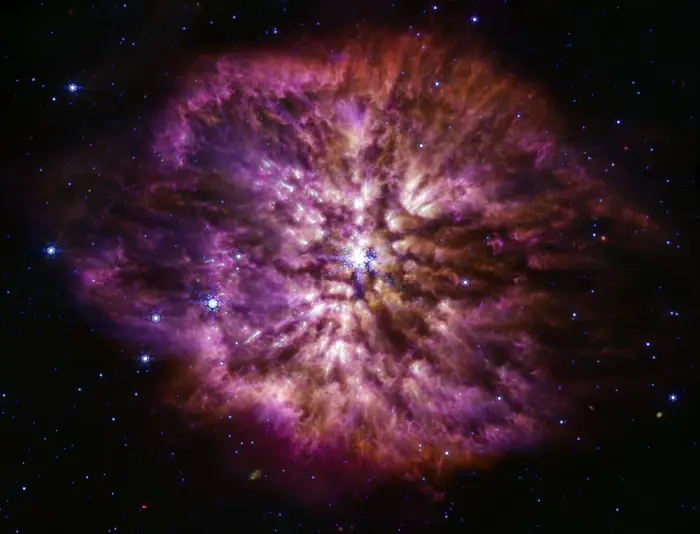
Wolf-Rayet stars are known to be efficient dust producers, and the Mid-Infrared Instrument (MIRI) on the NASA/ESA/CSA James Webb Space Telescope shows this to great effect. Cooler cosmic dust glows at the longer mid-infrared wavelengths, displaying the structure of WR 124’s nebula. The 10 light-years-wide nebula is made of material cast off from the ageing star in random ejections, and from dust produced in the ensuing turbulence. This brilliant stage of mass loss precedes the star’s eventual supernova, when nuclear fusion in its core stops and the pressure of gravity causes it to collapse in on itself. As MIRI demonstrates here, Webb will help astronomers to explore questions that were previously only available to theory, questions like how much dust stars like this create before going out as supernovae, and how much of that dust is large enough to survive the supernova event and go on to serve as a building block of future stars and planets. In this image red is assigned to wavelengths of 12.8 and 18 microns (F1280W, F1800W), green to 11.3 microns (F1130W), and blue to 7.7 microns (F770W). Image credit: NASA, ESA, CSA, STScI, Webb ERO Production Team
The questions of dust production are crucial to future discoveries regarding both the turbulent time of transformation late in the lives of WR stars and about the early history of the universe. The young universe was populated with similar stars that fused heavy elements in their cores that are now widespread in the current era.
Even though dust plays many essential roles in the workings of the universe, there is more dust than the current dust-formation theories can explain. In other words, there is an overall dust budget surplus in the universe and studying stars like WR 124 may help astronomers explain it. The data obtained by Webb will provide scientists with insights into the size of the dust grains and whether the grains are of sufficient size and quantity to survive the eventual supernova.
Cosmic dust is best observed in the infrared band and Webb’s two instruments – the Mid-Infrared Instrument (MIRI) and the Near-Infrared Camera (NIRCam) – provide real data and open up new possibilities for observing details in the dust and investigating dust production in environments like M1-67 and other Wolf-Rayet nebulae.
Webb’s Near-Infrared Camera (NIRCam) captured the brightness of the central star, showed with characteristic diffraction spikes, and the knotty details of the nebula, while the Mid-Infrared Instrument (MIRI) revealed the nebula’s clumpy structure.
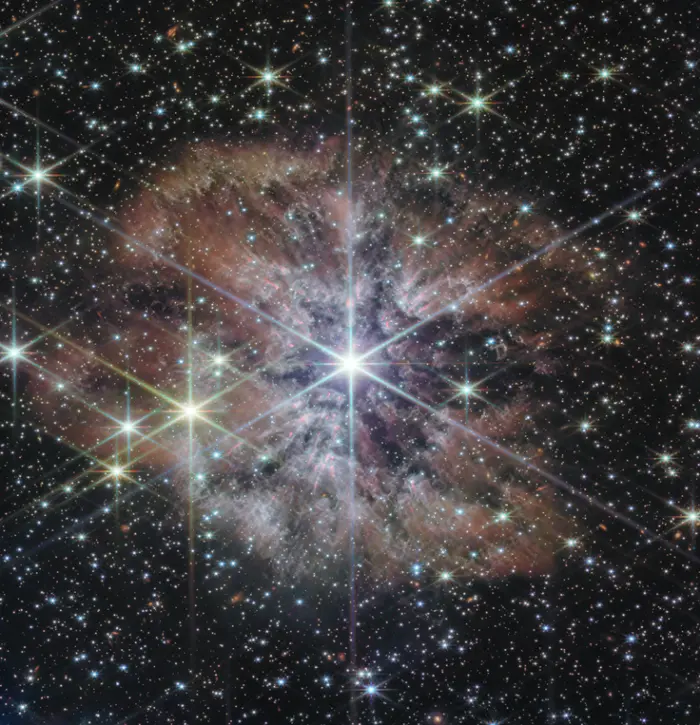
The NIRCam image of WR 124, image credit: Judy Schmidt (CC BY 2.0)
Name
WR 124 does not have a proper name approved by the International Astronomical Union (IAU). It is sometimes called Merrill’s Star, after its discoverer, the American astronomer Paul W. Merrill.
The abbreviation WR stands for Wolf-Rayet. Wolf-Rayet stars get their name from the French astronomers Charles Wolf and Georges Rayet, who discovered three unusual stars in the constellation Cygnus in 1867. These stars – now known as WR 134, WR 135, and WR 137 – showed broad emission lines in their spectra, which puzzled astronomers for several decades. They were later found to indicate the presence of helium, an element discovered in 1868.
WR 124 has the variable star designation QR Sagittae in the General Catalogue of Variable Stars.
Location
WR 124 lies in the constellation Sagitta, near the border with Aquila. The star appears near Okab (Zeta Aquilae), about a quarter of the way from Okab to Anser in the constellation Vulpecula. It lies in the same region of the sky as the Coathanger asterism.
Even though the star is exceptionally luminous, at a distance of 21,000 light-years it is too faint to be visible to the unaided eye.
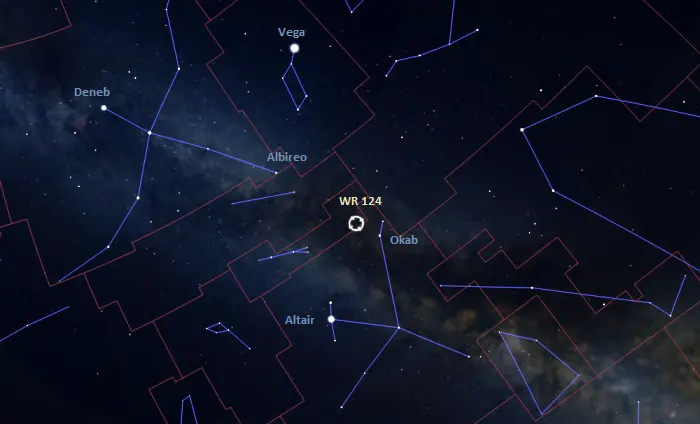
The location of WR 124 in the constellation Sagitta, image: Stellarium
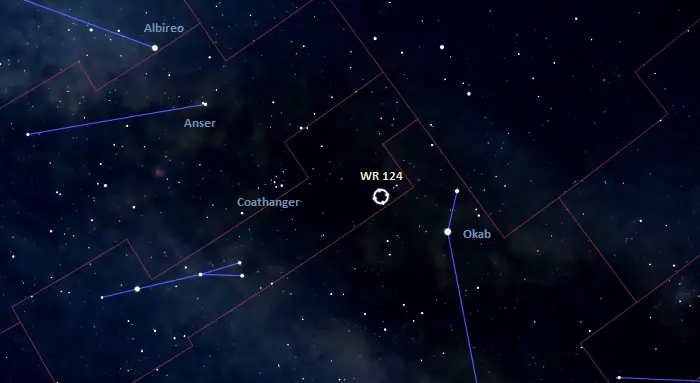
WR 124 location, image: Stellarium
Constellation
WR 124 is located in the constellation Sagitta. Representing the celestial Arrow, Sagitta is the third smallest constellation in the sky, after Crux (the Southern Cross) and Equuleus (the Foal). Despite its name, Sagitta does not appear near the constellation Sagittarius and is not associated with the zodiac constellation in mythology. It occupies 79.9 square degrees of the northern sky between the heads of the two prominent birds, Cygnus (the Swan) and Aquila (the Eagle). Most of the constellation lies within the Summer Triangle, a bright, large asterism formed by Deneb, Vega and Altair, the brightest stars in the constellations Cygnus, Lyra and Aquila.
Sagitta is one of the 48 Greek constellations, catalogued by Claudius Ptolemy of Alexandria in the 2nd century CE. In Greek mythology, it is associated with the arrow with which Heracles struck down the eagle that gnawed Prometheus’ liver. In some tales, it is taken to represent the arrow used by the god Apollo on the Cyclopes, who had made the thunderbolts with which Zeus had struck down Apollo’s son, the healer Asclepius.
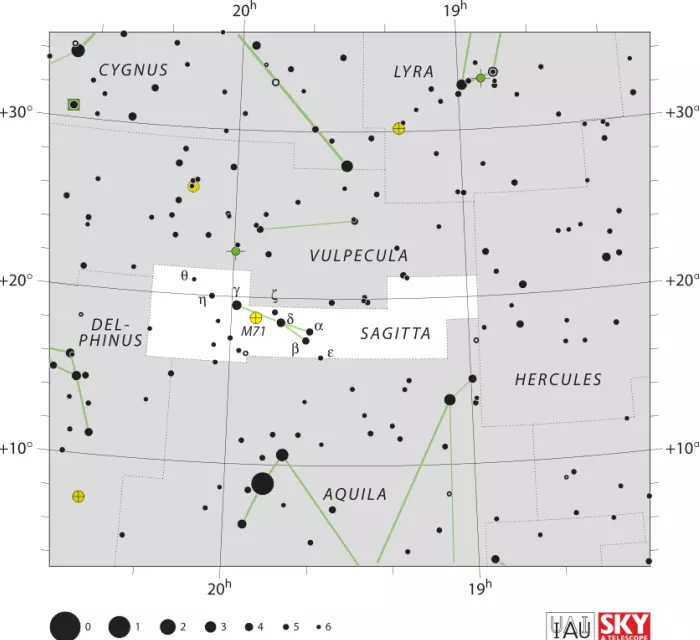
Sagitta constellation map by IAU and Sky&Telescope magazine
Even though it is one of the fainter constellations – its brightest star, Gamma Sagittae, shines at magnitude 3.47 – Sagitta is easily recognizable. Its five brightest stars form a distinctive arrow in the night sky.
Most of the brighter stars in Sagitta are evolved giants and supergiants more than 200 light-years away. They include the red giants Gamma Sagittae, the red bright giant Delta Sagittae, the yellow bright giant Sham (Alpha Sagittae), and the yellow giant Beta Sagittae. The constellation also hosts the variable supergiants FG Sagittae, S Sagittae and R Sagittae, as well as the Black Widow Pulsar, an eclipsing binary millisecond pulsar with a substellar companion.
Notable deep sky objects in Sagitta include the bright globular cluster Messier 71 and the planetary nebulae NGC 6886 and the Necklace Nebula (PN G054.2-03.4).
The best time of the year to see the stars and deep sky objects in Sagitta is during the month of August, when the constellation is high above the horizon in the evening. The entire constellation is visible from locations north of the latitude 70° S.
The 10 brightest stars in Sagitta are Gamma Sagittae (mag. 3.47), Delta Sagittae (mag. 3.82), Sham (Alpha Sge, mag. 4.38), Beta Sagittae (mag. 4.38), Zeta Sagittae (mag. 5.00), Eta Sagittae (mag. 5.09), 13 Sagittae (mag. 5.33), 11 Sagittae (mag. 5.53), 1 Sagittae (mag. 5.65), and Epsilon Sagittae (mag. 5.64 – 5.67).
WR 124
| Spectral class | WN8h |
| Variable type | Eruptive (WR) |
| B-V colour index | 0.69 |
| Apparent magnitude (V) | 11.50 ± 0.11 |
| Apparent magnitude (B) | 12.19 ± 0.16 |
| Apparent magnitude (J) | 8.578 ± 0.024 |
| Apparent magnitude (H) | 8.179 ± 0.018 |
| Apparent magnitude (K) | 7.732 ± 0.018 |
| Angular size | 2.007′ x 2.007′ |
| Absolute magnitude | −6.58 |
| Distance | 21,000 ± 2,000 light-years (6,400 ± 600 parsecs) |
| Parallax | 0.1568 ± 0.0140 mas |
| Radial velocity | 190 ± 7.4 km/s |
| Proper motion | RA: −2.517 ± 0.012 mas/yr |
| Dec.: −5.671 ± 0.012 mas/yr | |
| Mass | 20 M☉ |
| Luminosity | 562,000 L☉ |
| Radius | 11.93 R☉ |
| Temperature | 44,700 K |
| Age | 8.6 million years |
| Constellation | Sagitta |
| Right ascension | 19h 11m 30.8749167774s |
| Declination | +16° 51′ 38.200938279″ |
| Names and designations | WR 124, Merrill’s Star, QR Sagittae, HIP 94289, GCRV 11638, GSC 01586-00411, ALS 10196, IRAS 19092+1646, NSV 11797, PLX 4471, 2MASS J19113087+1651382, WEB 16426, TYC 1586-411-1, Gaia DR1 4513494201229646848, Gaia DR2 4513494205567536512, Gaia DR3 4513494205567536512, Sh 2-80, Hen 2-427, LBN 127, LBN 050.14+03.36, PK 050+03 1, ARO 10, VV 220, VV’ 481, Sharpless 2-80 (Sh 2-80), Minkowski 1-67 (M1-67) |